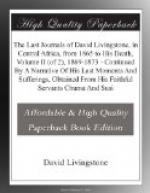2nd March, 1873.—It took us 7-1/2 hours’ punting to bring us to an island, and then the miserable weather rained constantly on our landing into the Boma (stockade), which is well peopled. The prairie is ten hours long, or about thirty miles by punting. Matipa is on an island too, with four bomas on it. A river, the Molonga, runs past it, and is a protection.[28]
The men wear a curious head-dress of skin or hair, and large upright ears.
3rd March, 1873.—Matipa paid off the men who brought us here. He says that five Sangos or coils (which brought us here) will do to take us to Kabende, and I sincerely hope that they will. His canoes are off, bringing the meat of an elephant. There are many dogs in the village, which they use in hunting to bring elephants to bay. I visited Matipa at noon. He is an old man, slow of tongue, and self-possessed; he recommended our crossing to the south bank of the Lake to his brother, who has plenty of cattle, and to goalong that side where there are few rivers and plenty to eat. Kabende’s land was lately overrun by Banyamwezi, who now inhabit that country, but as yet have no food to sell. Moanzabamba was the founder of the Babisa tribe, and used the curious plaits of hair which form such a singular head-dress here like large ears. I am rather in a difficulty, as I fear I must give the five coils for a much shorter task; but it is best not to appear unfair, although I will be the loser. He sent a man to catch a Sampa for me, it is the largest fish in the Lake, and he promised to have men ready to take my men over to-morrow. Matipa never heard from any of the elders of his people that any of his forefathers ever saw a European. He knew perfectly about Pereira, Lacerda, and Monteiro, going to Casembe, and my coming to the islet Mpabala. No trace seems to exist of Captain Singleton’s march.[29] The native name of Pereira is “Moenda Mondo:” of Lacerda, “Charlie:” of Monteiro’s party, “Makabalwe,” or the donkey men, but no other name is heard. The following is a small snatch of Babisa lore. It was told by an old man who came to try for some beads, and seemed much interested about printing. He was asked if there were any marks made on the rocks in any part of the country, and this led to his story. Lukerenga came from the west a long time ago to the River Lualaba. He had with him a little dog. When he wanted to pass over he threw his mat on the water, and this served as a raft, and they crossed the stream. When he reached the other side there were rocks at the landing place, and the mark is still to be seen on the stone, not only of his foot, but of a stick which he cut with his hatchet, and of his dog’s feet; the name of the place is Uchewa.
4th March, 1873.—Sent canoes off to bring our men over tothe island of Matipa. They brought ten, but the donkey could not come as far through the “tinga-tinga” as they, so they took it back for fear that it should perish. I spoke to Matipa this morning to send more canoes, and he consented. We move outside, as the town swarms with mice, and is very closely built and disagreeable. I found mosquitoes in the town.




